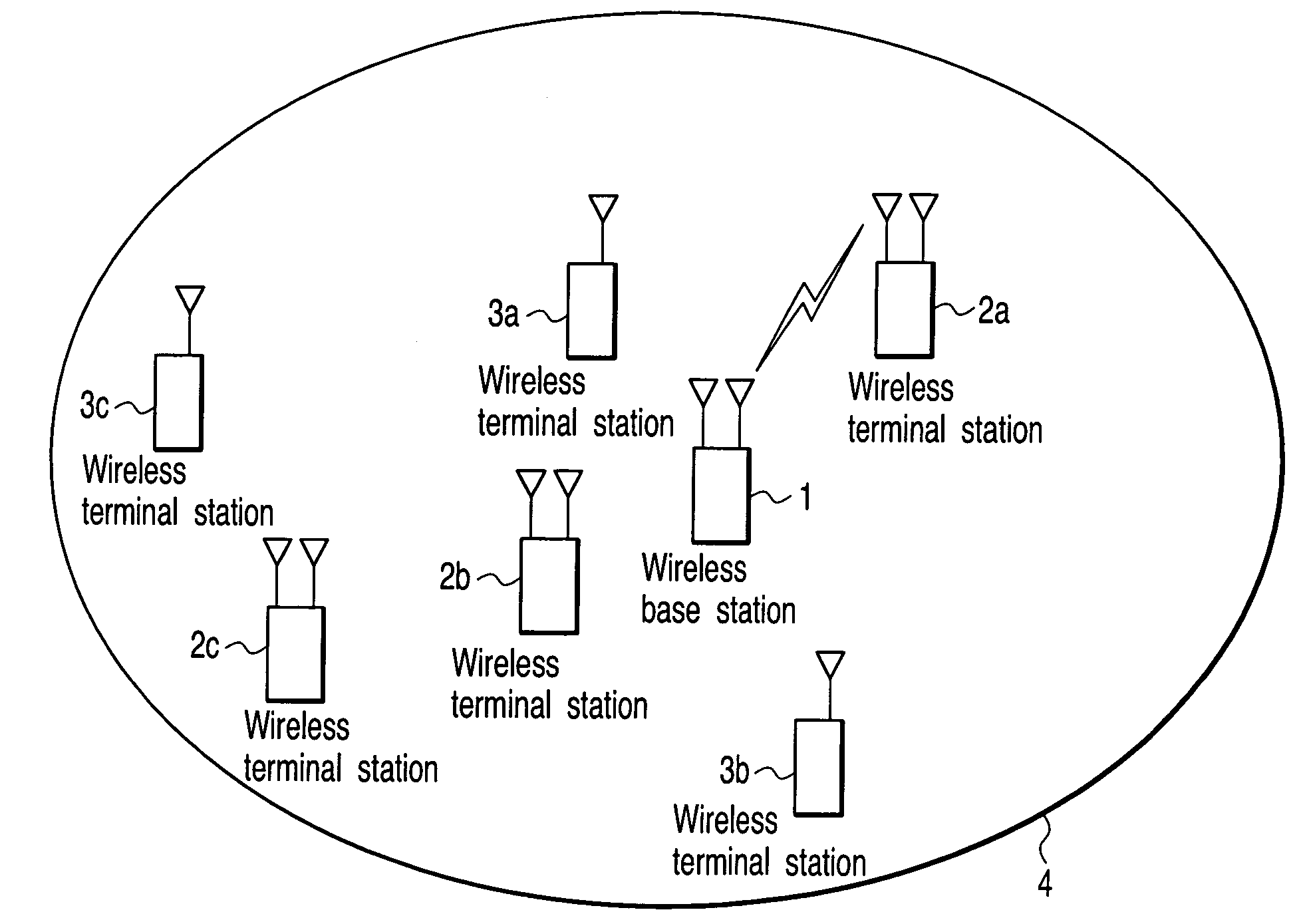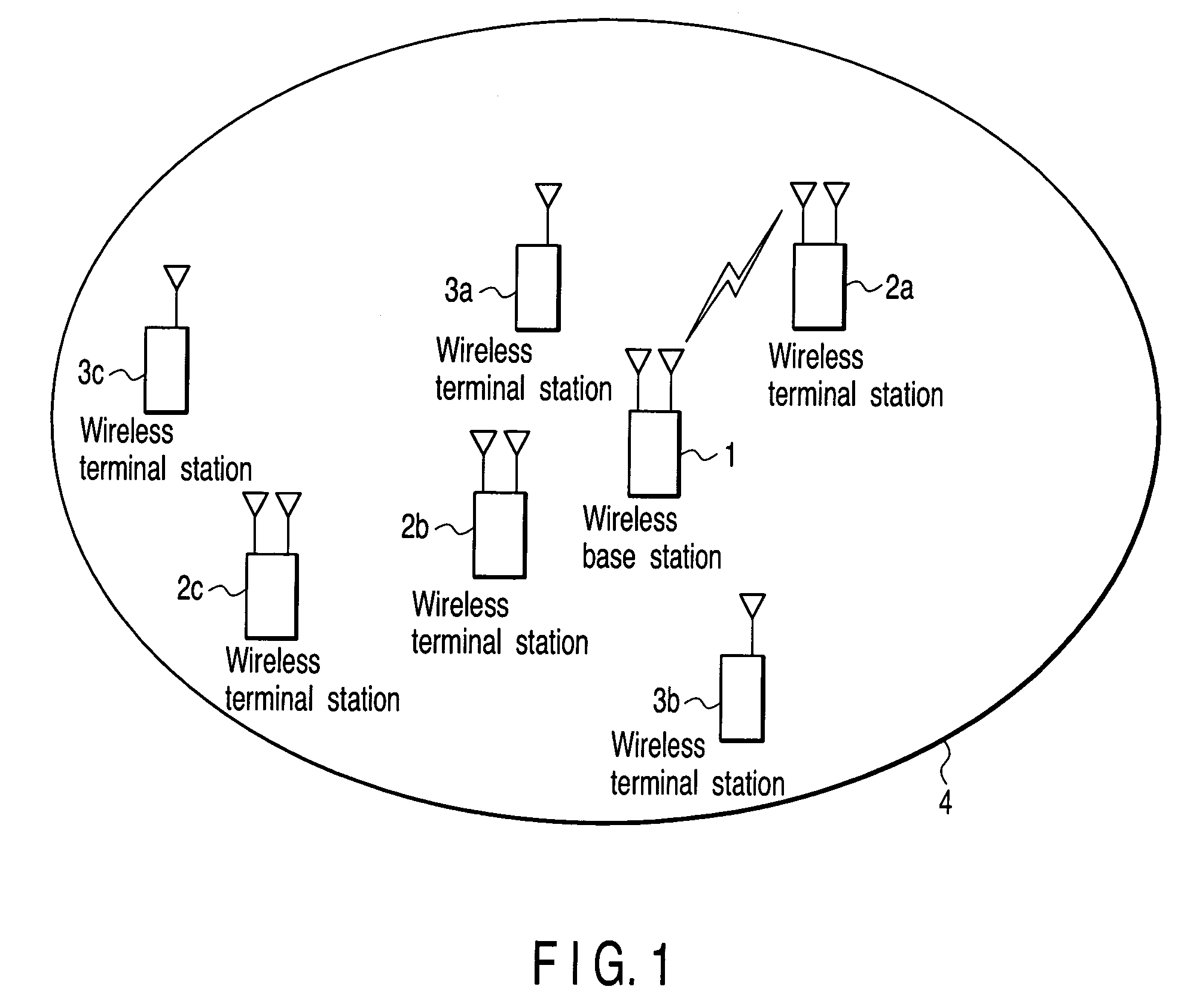Wireless communication method, wireless communication apparatus, and wireless communication system
a wireless communication and wireless communication technology, applied in wireless communication, wireless communication, broadcast service distribution, etc., can solve the problems of complicated control in the base station, insufficient overall data transmission efficiency of the system, and limited wireless communication to be performed in all frequency channels. , to achieve the effect of improving channel utilization efficiency and increasing the bandwidth of a frequency channel
- Summary
- Abstract
- Description
- Claims
- Application Information
AI Technical Summary
Benefits of technology
Problems solved by technology
Method used
Image
Examples
first embodiment
[0102]FIG. 1 is a block diagram showing a wireless communication system according to an embodiment of the present invention. A wireless communication system 4 comprises a wireless base station 1, wireless terminal stations 2a, 2b, and 2c belonging to the first group, and wireless terminal stations 3a, 3b, and 3c belonging to the second group. FIG. 1 shows the three wireless terminal stations 2 belonging to the first group and the three wireless terminal stations 3 belonging to the second group. However, the numbers of wireless terminal stations 2 and wireless terminal stations 3 are not specifically limited.
[0103]The wireless base station 1 allows the wireless terminal station 2 belonging to the first group and the wireless terminal station 3 belonging to the second group to perform wireless communication between them while sharing two different frequency channels. In the wireless communication system 4, one of the wireless terminal stations 2 belonging to the first group and one of...
second embodiment
[0110]FIG. 5 is a view showing the second example of the packet transmission / reception timing in this embodiment. Referring to FIG. 5, reference numeral 21 denotes a communication period in which the 40-MHz bandwidth is used; 22, a communication period in which the 20-MHz bandwidth is used; 23, a packet transmitted by a wireless base station 1 in FIG. 1; 24, a packet transmitted by a wireless terminal station 2 belonging to the first group in FIG. 1; and 41, a packet transmitted by a wireless terminal station 3 belonging to the second group. Assume that in this case, the wireless terminal station 2 belonging to the first group in FIG. 1 can perform communication using the 40-MHz bandwidth and freely switch the frequency channels shown in FIGS. 2A to 2D without any instruction from the wireless base station 1. Assume that the wireless terminal station 3 belonging to the second group in FIG. 1 can perform only communication using the 20-MHz bandwidth and can switch frequency channels ...
third embodiment
[0120]FIG. 7 is a view showing the third example of the packet transmission / reception timing in this embodiment. Referring to FIG. 7, reference numeral 21 denotes a communication period in which the 40-MHz bandwidth is used; 22, a communication period in which the 20-MHz bandwidth is used; 23, a packet transmitted by a wireless base station 1 in FIG. 1; 24, a packet transmitted by a wireless terminal station 2 belonging to the first group in FIG. 1; 41, a packet transmitted by a wireless terminal station 3 belonging to the second group; 61, a packet containing information indicating the permission of direct communication which the wireless base station 1 transmits; and 62, a packet transmitted before the wireless base station 1 transmits a packet containing information indicating the permission of direct communication in a communication period in which the 20-MHz bandwidth is used. Assume that in this case, as in the second embodiment, the wireless terminal station 2 belonging to th...
PUM
 Login to View More
Login to View More Abstract
Description
Claims
Application Information
 Login to View More
Login to View More - R&D
- Intellectual Property
- Life Sciences
- Materials
- Tech Scout
- Unparalleled Data Quality
- Higher Quality Content
- 60% Fewer Hallucinations
Browse by: Latest US Patents, China's latest patents, Technical Efficacy Thesaurus, Application Domain, Technology Topic, Popular Technical Reports.
© 2025 PatSnap. All rights reserved.Legal|Privacy policy|Modern Slavery Act Transparency Statement|Sitemap|About US| Contact US: help@patsnap.com



